12 Best content management systems You Should Know
- Mike Dodgson

- Jul 24
- 17 min read
Choosing the right content management system (CMS) is a foundational decision that shapes how you manage, present, and grow your digital presence. The platform you select dictates everything from daily content updates to your ability to integrate new functionalities or pivot your business strategy. For any organisation, from a local tradesperson to a national retailer, the wrong choice can lead to technical headaches, missed opportunities, and escalating costs. This guide is designed to prevent that.
We offer a detailed breakdown of the market's best content management systems, moving beyond marketing claims to provide a practical analysis. Our goal is to help you match your specific business requirements with the right platform. We will examine each option through the lens of real-world application, covering critical aspects like ease of use for non-technical teams, customisation potential for developers, and suitability for various business models such as e-commerce, service-based companies, and content-heavy publishers.
Each review includes direct links and screenshots to give you a clear view of the user interface and functionality. When picking which CMS to choose, remember the final goal: building a strong online presence. For businesses looking to maximise their digital impact, understanding the principles behind creating a great business website is a great help. This guide provides the information needed to make a confident, informed decision, whether you're launching a new site or migrating an existing one. We evaluate options from WordPress and Wix to specialized platforms like Shopify and Contentful, helping you find the perfect fit.
1. WordPress.org
Holding the title for powering over 43% of all websites on the internet, WordPress.org stands as a titan among the best content management systems. Its open-source nature means the core software is completely free to use. This platform's real power comes from its unparalleled customisation, offering a vast library of over 50,000 plugins and 9,000 themes to build virtually any type of site imaginable, from a simple blog to a complex e-commerce store.
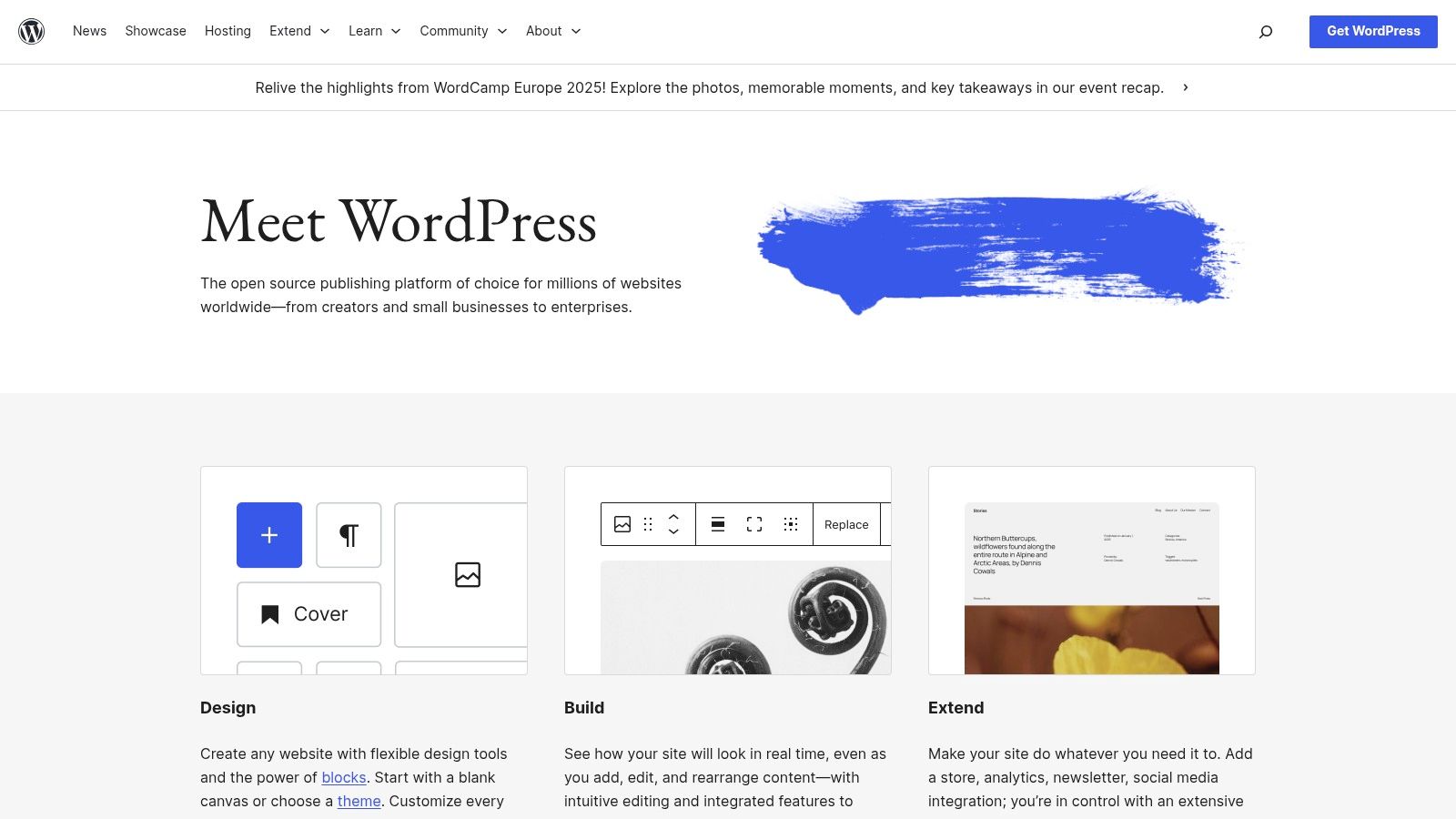
Unlike its counterpart, WordPress.com, this self-hosted version gives you complete control over your website's files, database, and functionality. This autonomy requires you to arrange your own web hosting and domain name, which introduces costs and a technical setup process. For businesses aiming to master their online presence, a deeper understanding of content marketing strategies for WordPress.org is beneficial.
Practical Use and Considerations
The platform is particularly well-suited for businesses that anticipate growth and need a system that can adapt. Its inherent SEO-friendly structure provides a solid foundation for search engine visibility right from the start. The user interface, centered around the block editor (Gutenberg), has become more intuitive over the years, though beginners might still face a learning curve compared to all-in-one website builders.
Key Advantage: "The sheer scale of the community means you can find a tutorial, plugin, or forum thread for almost any problem you encounter. This extensive support network is invaluable, especially for small businesses without a dedicated IT department."
Unique Features:
Total Ownership: You own your data and have full control over your site's code.
Plugin Ecosystem: The plugin repository can add functionality for e-commerce (WooCommerce), SEO (Yoast), security, and more.
Community Support: Access to a global community through forums and developer documentation.
Website: https://wordpress.org/
2. Wix
Wix has carved out a significant niche among the best content management systems by prioritizing ease of use. It is a cloud-based platform that combines website building with integrated hosting and CMS functionalities. Its main appeal lies in its drag-and-drop editor, which allows individuals and small businesses to create visually appealing websites without any prior coding knowledge.

This all-in-one approach simplifies the entire process from concept to launch, as you don't need to source separate hosting or manage technical back-end setups. Wix handles server maintenance, security updates, and performance monitoring, letting you focus purely on your site's appearance and content. For those starting from scratch, exploring some fundamental tips for Wix web design can provide a strong creative direction.
Practical Use and Considerations
The platform is an excellent choice for portfolios, small local businesses, and restaurants that need a professional online presence quickly. Its built-in tools for SEO, analytics, and marketing provide a solid starting point for digital outreach. While the interface is intuitive, the trade-off for this simplicity is a degree of creative and functional constraint; once you choose a template, you cannot switch to another without rebuilding your site.
Key Advantage: "Wix's App Market is a powerful resource, offering hundreds of third-party and native apps that can add booking systems, event calendars, or advanced contact forms with just a few clicks. This makes adding complex features incredibly accessible for non-developers."
Unique Features:
Wix ADI (Artificial Design Intelligence): An AI-powered tool that builds a personalised website for you after answering a few questions.
App Market: An extensive library of applications to add specific functionalities like e-commerce, bookings, and live chat.
All-in-One Solution: Hosting, domain, and security are bundled into the subscription plans, simplifying website management.
Website: https://www.wix.com/
3. Shopify
While many CMS platforms add e-commerce as a feature, Shopify is built from the ground up as a dedicated online retail solution with content management capabilities. It provides a comprehensive, all-in-one package that includes secure hosting, payment processing, and a full suite of tools to manage products and sales. This focus makes it one of the best content management systems for businesses whose primary goal is selling online.

Shopify simplifies the technical side of running an online store, handling security and updates so you can concentrate on your products and customers. While it's incredibly user-friendly, there are transaction fees on all plans if you don't use Shopify Payments. For those wanting deep customisation beyond the standard themes, exploring custom Liquid sections in Shopify offers a path to a more unique storefront. A deeper understanding of e-commerce marketing tactics is also beneficial for maximising sales.
Practical Use and Considerations
The platform is ideal for entrepreneurs launching their first online store and for established brands needing a reliable, high-performance system. Its clear interface and 24/7 support reduce the barriers to entry for non-technical users. The integrated blog and page creation tools are sufficient for standard content marketing, allowing businesses to attract customers through articles and guides directly within their store's domain.
Key Advantage: "The integrated nature of Shopify is its greatest strength. From inventory and shipping to marketing and payments, everything is managed within one dashboard, creating an efficient workflow for any retail business."
Unique Features:
All-in-One E-commerce: Hosting, security, and a payment gateway are all included.
App Store: Thousands of apps are available to add specific functions like dropshipping, customer reviews, or loyalty programs.
Reliable Infrastructure: The system handles traffic spikes and business growth without requiring technical intervention from the user.
Website: https://www.shopify.com/
4. Squarespace
Squarespace has carved out a niche as a design-first platform among the best content management systems. It is an all-in-one solution that bundles hosting, security, and a drag-and-drop editor into a single subscription. The platform is celebrated for its award-winning, mobile-ready templates that allow creatives, portfolios, and small businesses to present a polished and professional online image with minimal technical effort.

This integrated approach means users do not need to source their own web hosting or manage backend security updates, as it's all handled by Squarespace. Its pricing plans are tiered, offering different levels of functionality for personal sites, businesses, and e-commerce stores. While it provides less customisation freedom than open-source platforms, its appeal lies in its simplicity and the quality of its built-in tools.
Practical Use and Considerations
The platform is a strong choice for businesses where visual presentation is a key component, such as for photographers, designers, and boutique online shops. The user interface is clean and intuitive, making content updates straightforward. Built-in e-commerce and marketing tools, like inventory management and email campaigns, provide a solid foundation for small businesses to start selling online without needing third-party extensions.
Key Advantage: "The design quality of Squarespace templates is its greatest strength. You can create a website that looks bespoke and expensive in a fraction of the time and cost it would take with a custom build."
Unique Features:
Award-winning Templates: A curated selection of professional, aesthetically pleasing, and mobile-responsive designs.
All-in-One Platform: Hosting, domains, SSL security, and support are all included in one package.
Integrated E-commerce: Built-in tools for selling products, managing inventory, and processing payments.
Website: https://www.squarespace.com/
5. Joomla
Positioned as a powerful and adaptable option, Joomla is a free, open-source platform that strikes a balance between user-friendliness and developer-centric capabilities. It is renowned for its advanced user management and multilingual support, making it a strong contender among the best content management systems for complex websites like community portals, corporate intranets, or sophisticated online magazines. Its architecture is built for flexibility, serving users who need more than a simple blog but find other systems overly complex.
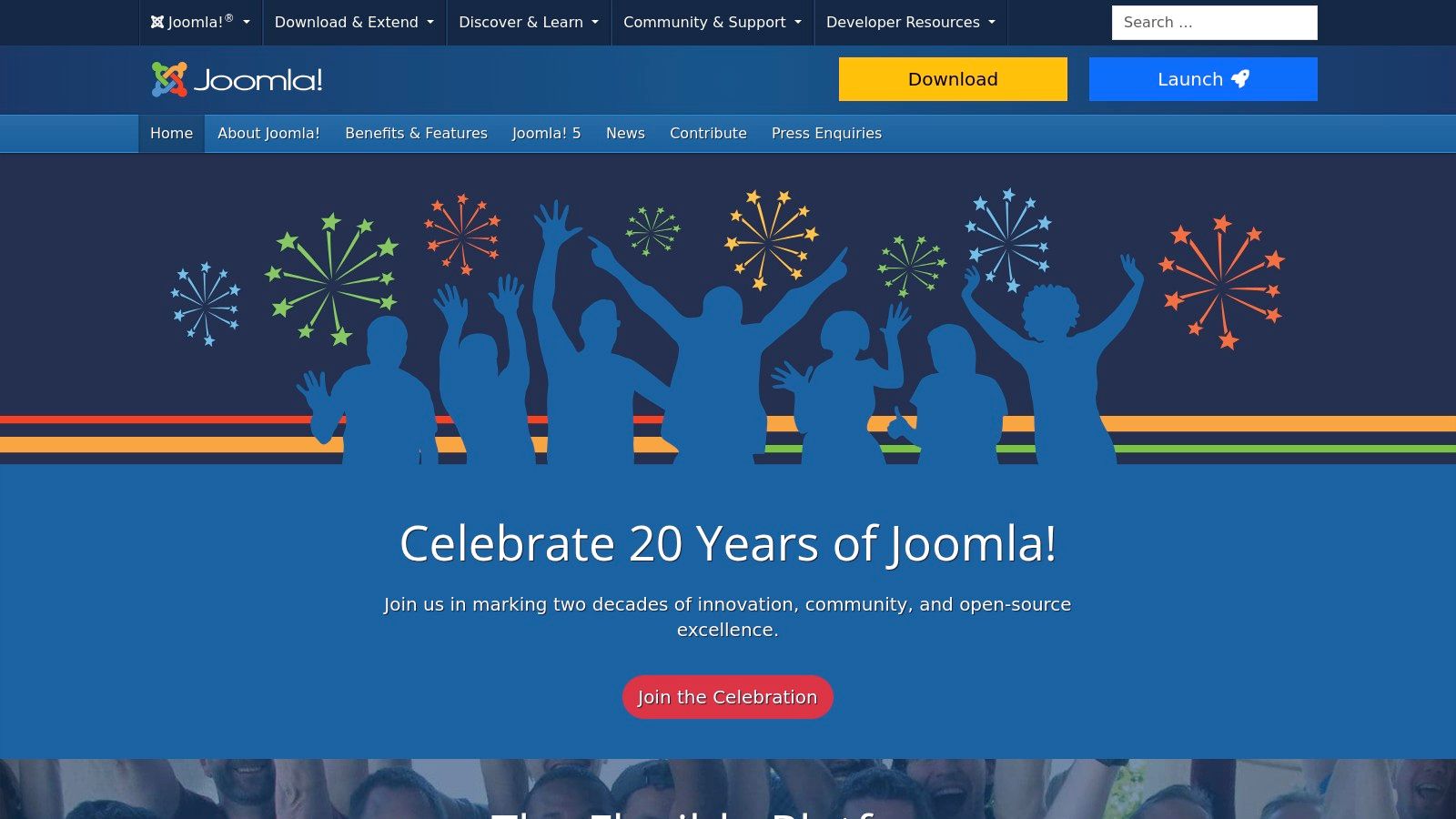
Like other open-source solutions, Joomla requires you to secure your own web hosting and domain name, incurring separate costs and a manual setup process. This self-hosted approach grants you full ownership of your site's data and code. The platform's extensive library of over 10,000 extensions and templates provides a solid foundation for customisation, allowing businesses to tailor their sites to very specific functional requirements without starting from scratch.
Practical Use and Considerations
Joomla is an excellent choice for websites that demand intricate content organization and precise user permissions. Its built-in Access Control List (ACL) is a standout feature, offering fine-grained control over who can view, edit, and manage different parts of the website. While its interface is more structured than some competitors, beginners may find the learning curve steeper, as navigating its administration panel requires some technical familiarity.
Key Advantage: "Joomla's native multilingual support is a major asset for any business aiming for a global audience. The ability to manage multiple language versions of your site directly within the core system saves considerable time and resources."
Unique Features:
Advanced User Management: Superior access control levels (ACL) for managing user permissions.
Extensive Extension Library: Thousands of verified extensions to add functionality for directories, e-commerce, and social networking.
Built-in Multilingual System: Create and manage a multilingual website without needing third-party plugins.
Website: https://www.joomla.org/
6. Drupal
For organisations requiring a highly structured and secure digital setup, Drupal is a formidable open-source option. Often mentioned in discussions about the best content management systems, it is celebrated by developers for its powerful architecture. It excels at managing complex, content-heavy websites such as government portals, university sites, and large corporate platforms where fine-grained control over permissions and content types is a top priority.
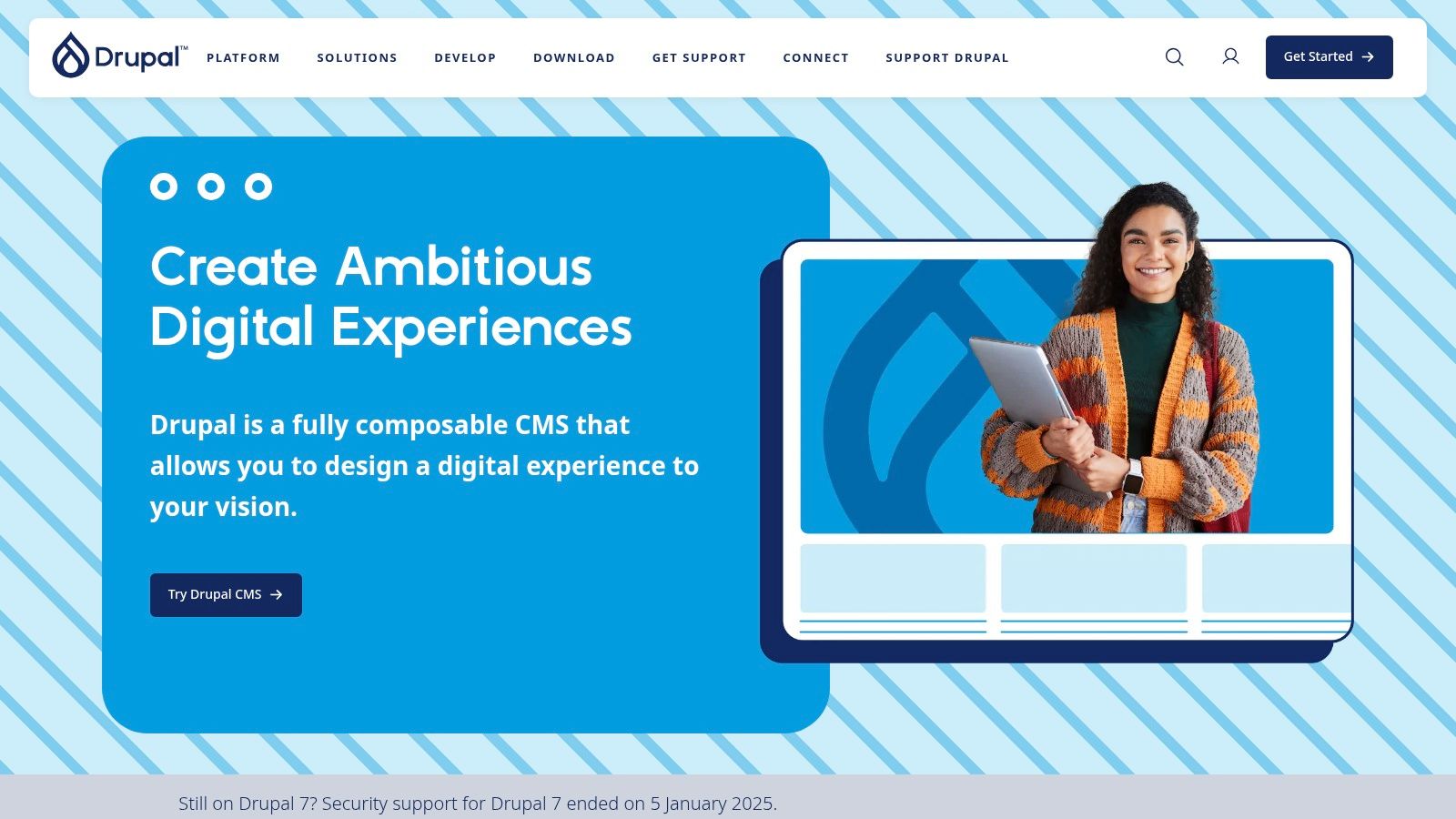
Similar to WordPress.org, Drupal is self-hosted, meaning you arrange your own hosting and domain. This setup grants you full command over your website's environment. Its design philosophy centers on a modular approach, allowing you to construct sophisticated digital experiences piece by piece. This makes it an excellent choice for websites that need to manage large amounts of data and diverse user roles with precision.
Practical Use and Considerations
Drupal is best suited for projects with developer support, as its initial setup and ongoing management demand technical knowledge. The learning curve is considerably steeper than for more user-friendly platforms, making it less ideal for solo entrepreneurs or small teams without a dedicated IT specialist. Its strength lies in building sites that require complex integrations and custom workflows, far beyond a standard blog or brochure website.
Key Advantage: "Drupal’s enterprise-grade security and user permission system are second to none. For organisations handling sensitive data, its rigorous security protocols and detailed access controls provide a level of confidence that is hard to match."
Unique Features:
Modular Architecture: Its "modules" allow for intricate functionality, from advanced forums to complex data taxonomies.
Advanced Security: Features enterprise-level security and regular, detailed security reports from a dedicated team.
Multilingual Support: Built-in multilingual capabilities are among the strongest of any CMS, perfect for global organisations.
Website: https://www.drupal.org/
7. Webflow
Webflow bridges the gap between no-code website builders and traditional content management systems, targeting designers and businesses who crave pixel-perfect control without writing code. It's an all-in-one platform providing a powerful visual design tool, a flexible CMS, and high-performance hosting, eliminating the need to juggle separate services. This integrated approach makes it one of the best content management systems for creating highly customized, professional websites.
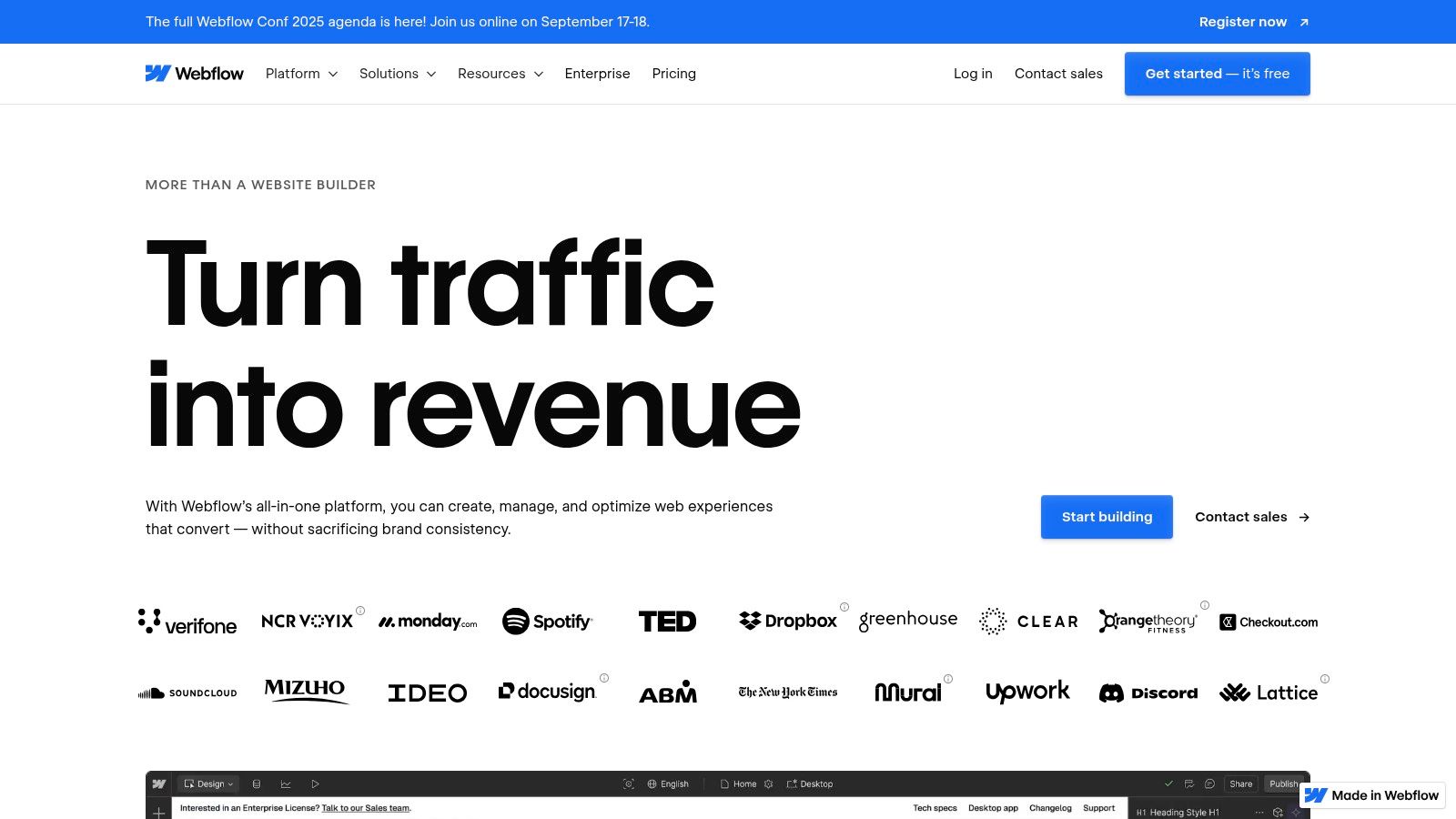
The platform translates visual design choices directly into clean, semantic HTML and CSS, giving users fine-grained control over every element's appearance and responsiveness. While it offers immense design freedom, its pricing structure is higher than some competitors, and its advanced e-commerce features are reserved for more expensive plans, making it a considered investment for businesses.
Practical Use and Considerations
Webflow is ideal for creative agencies, freelancers, and businesses that produce visually-rich marketing sites, portfolios, or blogs where brand identity and design precision are paramount. Its "CMS Collections" allow for the creation of structured, repeatable content types, perfect for team directories, project showcases, or resource libraries that non-technical team members can easily update. The learning curve is steeper than simple drag-and-drop builders, but Webflow University provides extensive, high-quality tutorials to guide new users.
Key Advantage: "The visual canvas offers unparalleled design freedom. You're not confined to a template's predefined structure; you can build completely custom layouts and interactions, which is a major benefit for brands with a unique visual identity."
Unique Features:
Visual Design Engine: A powerful interface that provides direct control over CSS properties without coding.
Integrated Hosting: Managed, high-speed hosting is included with site plans, handling security and updates.
Flexible Content: Create custom content structures (CMS Collections) for any type of data, from blog posts to real estate listings.
Website: https://webflow.com/
8. HubSpot CMS Hub
HubSpot CMS Hub is an integrated content management system built from the ground up for marketers and growing businesses. It combines website creation with the power of a customer relationship management (CRM) platform, aiming to provide a single source of truth for all marketing, sales, and service activities. Its primary appeal is for teams that want to create personalised digital experiences based on customer data.

Unlike open-source platforms, HubSpot is a fully-hosted SaaS product. This means it manages all the technical backend elements like security, performance, and updates for you. This approach makes it one of the best content management systems for non-technical users, but it comes at a higher price point, with tiered plans based on features and contact limits.
Practical Use and Considerations
The platform excels for businesses already invested in the HubSpot tools. The drag-and-drop editor simplifies page building, while built-in A/B testing and adaptive content features allow marketers to fine-tune pages for conversion without needing a developer. SEO recommendations are built directly into the content creation interface, offering real-time advice.
Key Advantage: "The native integration with HubSpot's CRM is its biggest strength. You can personalise content, calls-to-action, and forms based on a visitor's lifecycle stage, creating a truly tailored user journey that drives conversions."
Unique Features:
Integrated CRM: All website activity is directly connected to contact records in the CRM.
Smart Content: Show different content to website visitors based on their known properties.
Fully Managed Hosting: Includes a global CDN, SSL certificate, and 24/7 security monitoring.
Website: https://www.hubspot.com/products/cms
9. BigCommerce
BigCommerce is a dedicated e-commerce platform that also functions as one of the best content management systems for online retail. It provides a comprehensive solution for businesses looking to build and grow their online stores. The platform is designed with future growth in mind, offering features that support merchants from their first sale to reaching enterprise-level volumes, without charging transaction fees on any of its standard plans.
This CMS stands out by merging powerful e-commerce functionality directly with content creation tools. This integrated approach allows businesses to manage products, process payments, and publish blog posts all within a single dashboard. While there are fewer free themes available compared to some competitors, the available templates are highly geared for sales. For merchants focused on maximising sales, exploring conversion rate optimisation techniques can complement the platform's built-in features.
Practical Use and Considerations
The platform is an excellent choice for serious online retailers who prioritize built-in sales tools over extensive design flexibility. Its native multi-channel selling capabilities allow you to manage inventory across different marketplaces like Amazon, eBay, and social media from one central location. New users might find the interface more complex than simpler website builders, but the depth of features justifies the initial learning period.
Key Advantage: "The absence of transaction fees on all plans is a significant financial benefit, allowing businesses to retain more of their revenue as they grow. This, combined with 24/7 support, offers peace of mind."
Unique Features:
Comprehensive E-commerce Tools: Integrated product management, payment processing, and advanced shipping options.
Zero Transaction Fees: Merchants keep 100% of their revenue on all standard BigCommerce plans.
Multi-Channel Selling: Sell products directly on major marketplaces and social platforms from a single inventory.
Website: https://www.bigcommerce.com/
10. Magento (Adobe Commerce)
Primarily known as a heavyweight in the e-commerce world, Magento, now Adobe Commerce, also functions as one of the best content management systems for large-scale retail operations. This open-source platform is engineered for merchants who need deep customisation and control over every aspect of their online store, from product catalogues to the checkout experience. Its power lies in its complex architecture, designed to handle vast inventories and high traffic volumes with stability.
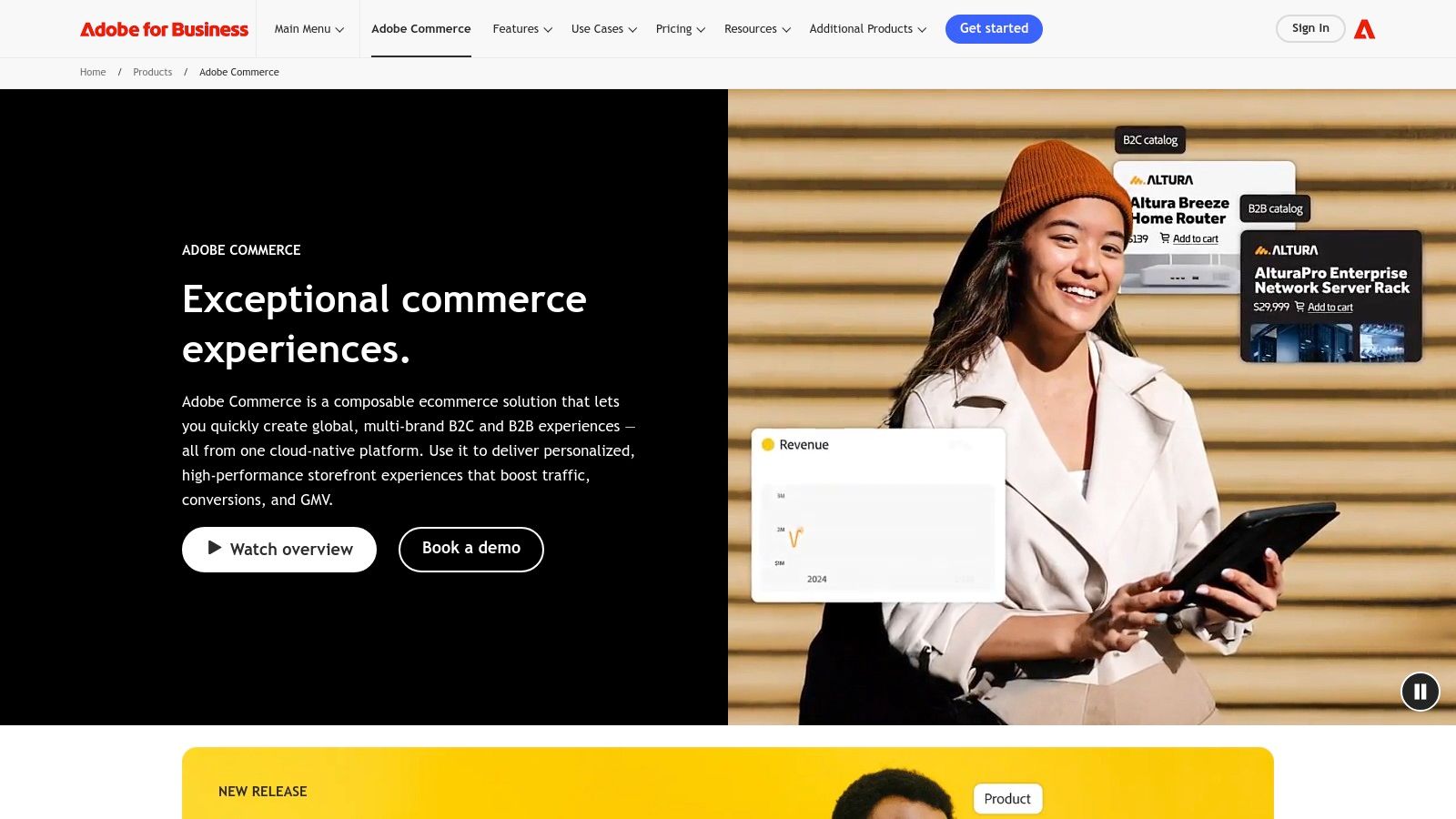
Unlike simpler platforms, Magento demands considerable technical knowledge and resources for setup and ongoing management. The total cost of ownership is higher, factoring in specialized hosting, development, and maintenance. This makes it a less practical choice for small businesses but a top contender for established enterprises looking to build a unique and powerful online presence without creative or functional limits.
Practical Use and Considerations
Magento is best suited for ambitious e-commerce businesses that require a system capable of supporting complex functionalities like multi-store management, advanced pricing rules, and international sales. Its built-in SEO and marketing tools provide a strong foundation for visibility in a competitive market. The admin interface is comprehensive but can be intimidating for users without prior experience, often necessitating dedicated staff or agency support.
Key Advantage: "The platform's unparalleled flexibility allows for the creation of truly bespoke shopping experiences. A business is never locked into a template; it can build unique features that directly address its specific customer needs and market position."
Unique Features:
Deep Customisation: Offers complete control over the design and functionality of your store.
Extensive Marketplace: A large library of third-party extensions adds features for marketing, accounting, and shipping.
Enterprise-Grade Architecture: Built to support large product catalogues and a high volume of transactions.
11. Contentful
Contentful pioneers the headless CMS category, presenting a powerful API-first approach that separates content from presentation. This modern architecture allows organisations to treat content as a structured, reusable asset. You can create content once and distribute it across any digital channel imaginable, from websites and mobile apps to smartwatches and digital signage, making it a cornerstone for omnichannel strategies.
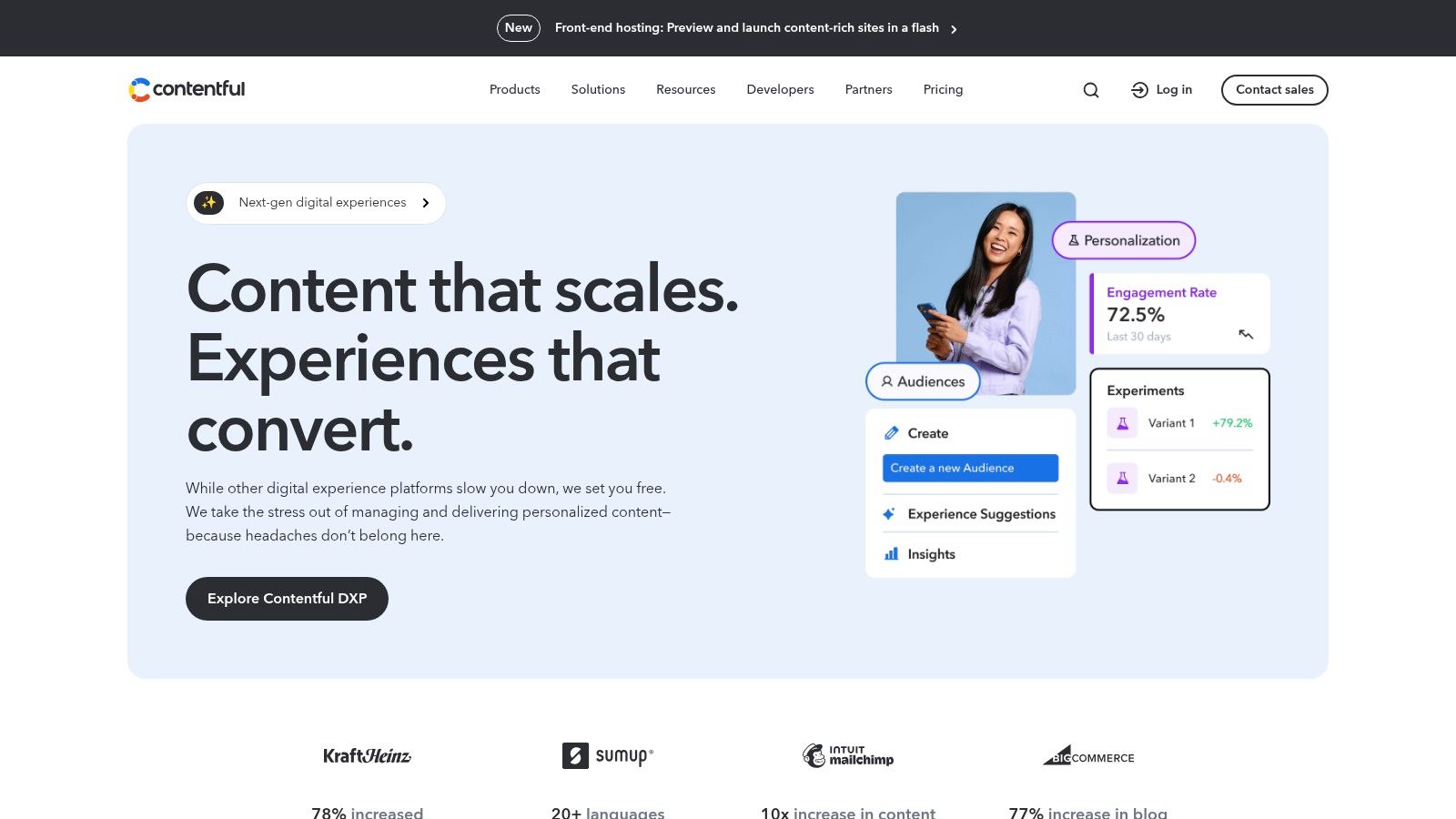
Unlike traditional, monolithic systems, Contentful gives developers the freedom to build front-end experiences using any technology stack they prefer. This makes it a popular choice among the best content management systems for tech-forward companies. Implementation requires skilled developers to connect the content repository to the user-facing application, and while a free community plan exists, enterprise-level features come with a significant price increase.
Practical Use and Considerations
The platform is ideal for large enterprises or digital-first businesses that manage a complex portfolio of digital properties and require high performance. Its clean user interface for content creators simplifies the process of editing and managing content models without needing technical knowledge. The primary challenge lies in the initial setup, which is entirely dependent on developer resources.
Key Advantage: "The API-driven nature provides unparalleled flexibility. Your marketing team can manage content independently while your development team builds and innovates on the front-end without being restricted by the CMS."
Unique Features:
API-First Approach: Delivers content via APIs to any platform or device.
Decoupled Architecture: Separates the back-end content repository from the front-end presentation layer.
Content Modelling: Allows you to create custom, structured content types for maximum reusability.
Website: https://www.contentful.com/
12. Kentico
Kentico presents a fully integrated digital experience platform (DXP) that combines content management, e-commerce, and online marketing into a single solution. It is designed for businesses that need a comprehensive toolset to manage sophisticated digital marketing campaigns and complex websites without piecing together multiple systems. This approach makes it one of the best content management systems for mid-sized to enterprise-level organisations seeking a unified platform.
Its all-in-one nature means marketing automation, email marketing, and A/B testing are built directly into the CMS. This removes the common integration challenges found with other platforms. Kentico operates on a proprietary licence model, so it comes with a higher price tag and dedicated support, positioning it as a premium option for businesses with the budget for a powerful, consolidated system.
Practical Use and Considerations
The platform is well-suited for marketing teams that require fine-grained control over personalization and lead nurturing within their website. The drag-and-drop page builder simplifies content creation for non-technical users, allowing them to construct rich pages without developer assistance. Still, implementing advanced customisations or integrating with bespoke corporate systems typically requires a developer with .NET experience, adding to the total cost of ownership.
Key Advantage: "The built-in marketing automation is a significant benefit. Being able to create customer journeys, score leads, and personalise content based on user behaviour directly within the CMS saves a tremendous amount of time and resources."
Unique Features:
Integrated Marketing Suite: Includes email marketing, lead scoring, and A/B testing.
E-commerce Functionality: Provides native tools for managing products, checkouts, and payment processing.
Strong Security: Offers dependable security features and adheres to compliance standards like GDPR.
Website: https://www.kentico.com/
Top 12 CMS Solutions Feature Comparison
CMS Platform | Core Features | User Experience | Value Proposition | Target Audience | Price Points |
|---|---|---|---|---|---|
WordPress.org | 50,000+ plugins, SEO-friendly | Flexible, steep learning curve | Highly customizable, free | Developers, bloggers, businesses | Free, hosting separate |
Wix | 800+ templates, built-in SEO | Easy drag-and-drop, beginner-friendly | All-in-one, hosting included | Small businesses, beginners | Free plan with branding; paid plans available |
Shopify | E-commerce tools, 100+ themes | Intuitive, 24/7 support | Dependable, secure hosting | E-commerce businesses | Monthly subscription + transaction fees |
Squarespace | Award-winning templates, SEO tools | Professional design, all-in-one | Design-focused, hosting included | Creatives, small businesses | Paid plans, higher cost than Wix |
Joomla | 10,000+ extensions, multilingual | Flexible, steep learning curve | Customizable, free | Developers, advanced users | Free, hosting separate |
Drupal | 40,000+ modules, strong security | Technical setup, for growth | Powerful, secure | Developers, enterprise sites | Free, hosting separate |
Webflow | Visual editor, CMS, hosting | Flexible design, no coding | Integrated CMS & hosting | Designers, small-medium businesses | Paid plans, higher cost |
HubSpot CMS Hub | Drag-and-drop, SEO, integrated CRM | User-friendly, marketing tools | All-in-one marketing CMS | Marketers, business owners | Paid plans, premium pricing |
BigCommerce | E-commerce tools, multichannel selling | For growth, 24/7 support | No transaction fees | Growing e-commerce businesses | Paid subscription plans |
Magento (Adobe) | Customizable, SEO, growth architecture | Powerful, technical; resource-heavy | Enterprise-grade e-commerce | Large e-commerce businesses | Higher cost; hosting & development separate |
Contentful | API-first, for growth, multi-platform | Developer focused | Omnichannel content delivery | Enterprises, developers | Paid plans, premium pricing |
Kentico | CMS, e-commerce, marketing automation | Comprehensive, technical | All-in-one marketing platform | Mid-large businesses | Paid plans, higher cost |
Final Thoughts
Navigating the world of content management systems can feel like a significant undertaking, but the journey to finding the right platform is a foundational step for your digital presence. We have explored a wide spectrum of options, from the ubiquitous WordPress.org with its boundless customisation, to the integrated marketing powerhouse of HubSpot CMS Hub. Each system presents a unique set of tools, philosophies, and operational models tailored to different business needs and technical abilities.
The key takeaway is that the concept of a single "best content management system" is a myth. The ideal choice is entirely relative to your specific objectives, resources, and long-term vision. An e-commerce startup will find Shopify or BigCommerce incredibly effective for getting a store online quickly, while a large enterprise with complex security needs might gravitate towards the structured control of Drupal or Adobe Commerce. For creatives and small businesses focused on aesthetics and ease of use, platforms like Squarespace and Wix offer polished, accessible solutions.
Making Your Decision: A Practical Guide
Before you commit to a platform, conduct a thorough internal audit. This process moves beyond feature lists and gets to the heart of what your organisation truly needs to succeed online. Organize your thoughts around these core areas:
Technical Proficiency: Be honest about your team's skills. Do you have developers ready to work with a complex system like Drupal, or do you need a no-code, drag-and-drop interface like Wix? Choosing a system that outstrips your technical capacity can lead to frustration and reliance on expensive external support.
Business Model Alignment: Your CMS should support your primary business function. For a content-heavy publication or a blog, WordPress or Joomla offers superior content organization. For a direct-to-consumer brand, the integrated sales and marketing tools within Shopify are built for commerce from the ground up.
Growth Trajectory: Where do you see your business in five years? A simple, free platform might be perfect for a launch, but will it support multi-language sites, complex integrations, or advanced marketing automation as you expand? Consider the platform’s ability to grow with you. Headless CMS options like Contentful, for instance, offer near-infinite flexibility for future applications.
Total Cost of Ownership: Look beyond the initial subscription fee. Factor in the costs of themes, plugins, apps, developer fees, maintenance, and hosting. An open-source platform might be "free" to download, but its long-term operational cost could exceed that of a fully-hosted SaaS solution.
Your Next Steps
With this information, you can now revisit the platforms we've discussed with a clearer perspective. Create a shortlist of two or three top contenders. Most SaaS platforms offer free trials; use them extensively. Build a test page, upload some content, and explore the back-end dashboard. For open-source options, find demos or tutorials to get a feel for the user experience.
Choosing your content management system is not just a technical decision; it's a strategic business decision that will influence your marketing, sales, and operational efficiency for years to come. By grounding your choice in a clear understanding of your unique requirements, you set your organisation up for sustainable growth and digital success.
Selecting the right CMS is the first step, but building a powerful online presence requires ongoing expertise. At Digital Sprout, we specialize in creating high-performance websites and executing SEO strategies that drive meaningful traffic on platforms like WordPress. Visit Digital Sprout to see how our tailored web design and SEO services can help your business flourish online.
.jpg)